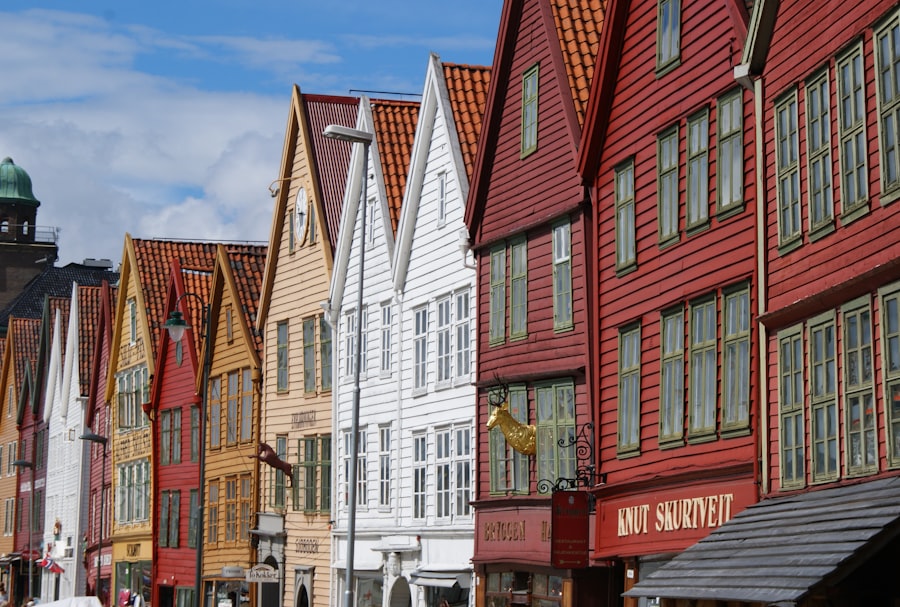In Norway, the arrival of Easter is not merely marked by the traditional festivities associated with the holiday; it is also heralded by a unique cultural phenomenon known as ‘Påskekrim.’ This term, which translates to ‘Easter crime,’ refers to the widespread practice of reading crime novels during the Easter holiday. As families gather in cabins or homes, they often indulge in thrilling tales of mystery and suspense, making ‘Påskekrim’ an integral part of the Norwegian Easter experience. The allure of these gripping narratives provides a perfect counterbalance to the serene landscapes and the celebratory atmosphere of the season.
The tradition of ‘Påskekrim’ has grown to become a hallmark of Norwegian culture, intertwining with the country’s literary heritage. It is not just a passing trend; it has evolved into a beloved ritual that captivates readers of all ages. As the snow begins to melt and the days grow longer, Norwegians find solace in the pages of crime novels, immersing themselves in stories that often reflect the darker aspects of human nature.
This article will explore the origins, cultural significance, and future of ‘Påskekrim,’ shedding light on how this unique tradition has become a defining feature of Norwegian society. Your journey to a smooth relocation starts here. Talk one-on-one with a Norway Relocation specialist and turn your plan into a reality. https://norwayrelocation.no/one-hour-strategy-session/
Summary
- ‘Påskekrim’ is a Norwegian Easter tradition of reading crime novels and watching crime TV shows and films.
- The tradition of Easter crime novels in Norway dates back to the 1920s, with the publication of crime novels during Easter to boost book sales.
- ‘Påskekrim’ has become a cultural phenomenon in Norway, with people actively participating in the tradition every Easter.
- Popular Norwegian authors like Jo Nesbø and Karin Fossum have contributed to the tradition with their Easter crime novels.
- Publishing houses play a significant role in promoting Easter crime novels and capitalizing on the ‘Påskekrim’ tradition in Norway.
The Origins of Easter Crime Novels in Norway
The roots of ‘Påskekrim’ can be traced back to the early 20th century when Norwegian authors began experimenting with crime fiction. The genre gained traction in the 1920s and 1930s, with writers like Nordahl Grieg and later, the iconic detective novelist, Sjöwall and Wahlöö, paving the way for future generations. However, it was not until the 1960s that ‘Påskekrim’ truly began to take shape as a distinct cultural phenomenon.
The first significant push came from a marketing campaign by a Norwegian publisher, which cleverly timed the release of crime novels to coincide with the Easter holiday. This strategic move proved to be a masterstroke, as it tapped into the growing popularity of crime fiction in Norway. The idea was simple yet effective: promote thrilling stories that could be enjoyed during the long Easter break.
As families retreated to their holiday cabins or gathered around their living rooms, they found themselves captivated by tales of murder and intrigue. This marked the beginning of a tradition that would soon become synonymous with Easter in Norway.
The Tradition of Crime TV Shows and Films During Easter

In addition to literature, the tradition of ‘Påskekrim’ has extended into the realm of television and film. Each Easter, Norwegians eagerly anticipate a selection of crime dramas and thrillers that are broadcast during the holiday period. These shows often feature gripping plots and complex characters, mirroring the themes found in popular crime novels.
The combination of visual storytelling and literary intrigue creates an immersive experience that resonates deeply with viewers. The popularity of crime TV shows during Easter has further solidified ‘Påskekrim’ as a cultural staple. Networks strategically schedule these programmes to coincide with family gatherings, ensuring that audiences are drawn into the suspenseful narratives just as they would be with a good book.
This synergy between literature and television has fostered a sense of community among viewers, as families discuss plot twists and character developments over Easter meals. The shared experience of engaging with crime stories has become a bonding ritual for many Norwegians.
How ‘Påskekrim’ Became a Cultural Phenomenon in Norway
The rise of ‘Påskekrim’ as a cultural phenomenon can be attributed to several factors. Firstly, Norway’s long winters and dark evenings create an ideal backdrop for crime stories, allowing readers to immerse themselves in narratives that explore human psychology and moral dilemmas. The stark contrast between the serene beauty of Norway’s landscapes and the often grim subject matter of crime fiction adds an intriguing layer to the reading experience.
Moreover, the accessibility of crime novels has played a significant role in their popularity during Easter. Publishers have capitalised on this trend by releasing special editions and curated collections specifically for the holiday season. Bookstores across Norway prominently display these titles, making it easy for readers to find their next gripping read.
This marketing strategy has not only boosted sales but has also reinforced ‘Påskekrim’ as an essential part of Norwegian Easter traditions.
Popular Norwegian Authors and Their Easter Crime Novels
Several Norwegian authors have made significant contributions to the ‘Påskekrim’ genre, each bringing their unique style and perspective to crime fiction. Jo Nesbø is perhaps one of the most well-known names internationally, with his Harry Hole series captivating readers around the world. His intricate plots and richly developed characters have made his books a staple for those seeking thrilling narratives during Easter.
Another notable author is Unni Lindell, whose novels often delve into psychological themes while maintaining a gripping pace. Her ability to weave complex narratives has earned her a dedicated following among Norwegian readers. Additionally, authors like Gunnar Staalesen and Anne Holt have also made their mark on the genre, each contributing to the diverse landscape of Norwegian crime fiction.
Their works not only entertain but also reflect societal issues, making them relevant and thought-provoking reads during the Easter season.
The Role of Publishing Houses in Promoting Easter Crime Novels

Publishing houses have played a crucial role in promoting ‘Påskekrim’ and ensuring its continued success in Norway. By strategically timing releases to coincide with Easter, publishers have tapped into a lucrative market that thrives on seasonal reading habits. Special promotions, themed book displays, and curated lists of recommended titles have all contributed to making crime novels an essential part of the holiday experience.
Moreover, publishers often collaborate with authors to create engaging marketing campaigns that highlight new releases or classic titles suitable for Easter reading. This proactive approach not only boosts sales but also fosters a sense of excitement around ‘Påskekrim.’ As readers eagerly anticipate new titles each year, publishing houses have successfully established a tradition that keeps crime fiction at the forefront of Norwegian culture during this festive season.
The Influence of ‘Påskekrim’ on Norwegian Society
The influence of ‘Påskekrim’ extends beyond mere entertainment; it has become a lens through which Norwegians explore societal issues and moral dilemmas. Many crime novels tackle themes such as justice, morality, and human nature, prompting readers to reflect on their own values and beliefs. This introspection is particularly poignant during Easter, a time traditionally associated with renewal and reflection.
Furthermore, ‘Påskekrim’ has fostered discussions about crime and safety within Norwegian society. As readers engage with complex narratives that often mirror real-life issues, they become more aware of societal challenges and injustices. This heightened awareness can lead to meaningful conversations among friends and family during Easter gatherings, making ‘Påskekrim’ not just a source of entertainment but also a catalyst for social dialogue.
How Norwegians Celebrate Easter with Crime Novels
Easter celebrations in Norway are often characterised by a blend of traditional customs and modern practices, with ‘Påskekrim’ occupying a central role in this unique tapestry. Families typically gather for meals, partake in outdoor activities such as skiing or hiking, and enjoy quality time together—all while indulging in their favourite crime novels. It is common for individuals to exchange recommendations or even gift books as part of their Easter celebrations.
In many households, reading becomes a communal activity during this time. Family members may take turns reading aloud from their chosen novels or engage in discussions about plot twists and character motivations. This shared experience not only enhances familial bonds but also reinforces the cultural significance of ‘Påskekrim’ as an integral part of Norwegian Easter traditions.
The Impact of ‘Påskekrim’ on the Norwegian Publishing Industry
The success of ‘Påskekrim’ has had a profound impact on the Norwegian publishing industry as a whole. With increasing demand for crime fiction during Easter, publishers have recognised the potential for growth within this niche market. As a result, there has been a surge in new authors entering the genre, leading to a diverse array of voices and perspectives being represented in Norwegian literature.
Additionally, the popularity of ‘Påskekrim’ has encouraged publishers to invest in marketing strategies that promote not only established authors but also emerging talent. This focus on nurturing new voices has enriched the literary landscape in Norway, ensuring that readers have access to fresh narratives that continue to captivate audiences year after year.
The Global Appeal of Easter Crime Novels from Norway
While ‘Påskekrim’ is deeply rooted in Norwegian culture, its appeal has transcended national borders. International readers have discovered the charm and complexity of Norwegian crime fiction, leading to translations and adaptations that have garnered attention worldwide. Authors like Jo Nesbø have achieved global recognition, with their works being translated into multiple languages and adapted for film and television.
This global interest in Norwegian crime novels has opened up new avenues for cultural exchange and collaboration within the literary community. As international readers embrace ‘Påskekrim,’ it serves as a bridge between cultures, allowing for shared experiences through storytelling that resonates across different backgrounds.
The Future of ‘Påskekrim’ and its Continued Influence on Norwegian Culture
As we look towards the future, it is clear that ‘Påskekrim’ will continue to hold a significant place within Norwegian culture. The enduring popularity of crime fiction during Easter speaks to its ability to captivate readers while reflecting societal issues and moral complexities. With new authors emerging and established voices continuing to thrive, there is no shortage of compelling narratives waiting to be explored.
Moreover, as Norwegians increasingly embrace digital platforms for reading and sharing stories, ‘Påskekrim’ is likely to evolve further in response to changing consumer habits. The integration of technology into literature may lead to innovative storytelling formats that enhance reader engagement during Easter celebrations. In conclusion, ‘Påskekrim’ is more than just a seasonal trend; it is a cultural phenomenon that encapsulates the essence of Norwegian society—its values, its challenges, and its love for storytelling.
As families gather each Easter with their favourite crime novels in hand, they partake in a tradition that not only entertains but also fosters connection and reflection within their communities.
Register for a Norwegian class at the NLS Norwegian Language School now!

